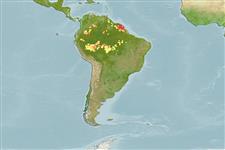Classification / Names
Common names | Synonyms | Catalog of Fishes (gen., sp.) | ITIS | CoL | WoRMS | Cloffa
Environment / Climate / Range
Ecology
Freshwater; benthopelagic; potamodromous (Ref. 51243). Tropical, preferred ?
South America: Tributaries of middle and lower Amazon basin, including Rios Trombretas, Jari, Tapajós, Xingu, Tocantins, and in the coastal rivers of Guyana, Suriname, Fr Guiana; Rios Araguari and Amapá, state of Amapá, Brazil; lower reaches of Río Orinoco, Venezuela.
Length at first maturity / Size / Weight / Age
Maturity: Lm ?, range 22 - 22 cm
Max length : 100.0 cm SL male/unsexed; (Ref. 12225); max. published weight: 40.0 kg (Ref. 12225)
Frequently occurs in counter current zones of principal rivers and creeks. Feeds mainly on fish but also on other animals that fall into the water like small terrestrial invertebrates. Is active at dusk and at night. Reproduction takes place at the onset of the rainy season from December to March. Depending on the size, the female can carry around 6,000 to 60,000 eggs (Ref. 12225). Known for the quality of its flesh (Ref. 27188).
Life cycle and mating behavior
Maturity | Reproduction | Spawning | Eggs | Fecundity | Larvae
Planquette, P., P. Keith and P.-Y. Le Bail, 1996. Atlas des poissons d'eau douce de Guyane. Tome 1. Collection du Patrimoine Naturel Volume 22, MNHN, Paris & INRA, Paris. 429 p. (Ref. 12225)
IUCN Red List Status (Ref. 115185)
CITES (Ref. 94142)
Not Evaluated
Threat to humans
Harmless
Human uses
Aquarium: commercial
More information
ReferencesAquacultureAquaculture profileStrainsGeneticsAllele frequenciesHeritabilityDiseasesProcessingMass conversion
Tools
Special reports
Download XML
Internet sources
